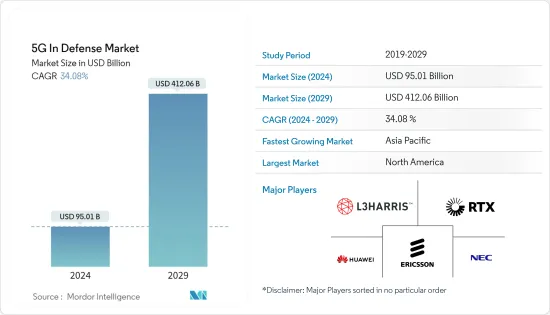
|
시장보고서
상품코드
1521428
방위 분야 5G : 시장 점유율 분석, 산업 동향 및 통계, 성장 예측(2024-2029년)5G In Defense - Market Share Analysis, Industry Trends & Statistics, Growth Forecasts (2024 - 2029) |
||||||
방위 분야 5G 시장 규모는 2024년 950억 1,000만 달러로 추정되며, 2029년에는 4,120억 6,000만 달러에 달할 것으로 예상되며, 예측 기간(2024-2029년) 동안 34.08%의 CAGR을 기록할 것으로 예상됩니다.

주요 하이라이트
- 빅데이터에 대한 의존도가 높아짐에 따라 국방 장비의 5G 네트워크에 대한 수요가 증가할 것으로 예상됩니다. 결정적인 의사결정을 위한 실시간 데이터 활용이 증가함에 따라 상당한 양의 데이터 수집이 요구되고 있습니다. 5G 네트워크는 더 빠르고 철저한 통신을 통해 방대한 양의 데이터를 더 빠르게 수집할 수 있는 능력을 갖추게 될 것이며, 이 새로운 무선 네트워크를 통해 무인항공기와 감시용 드론에서 지휘부로 실시간 데이터 전송이 가능해져 상황 인식과 전술 정찰을 강화할 수 있을 것으로 보입니다. 상황 인식과 전술 정찰을 강화할 수 있습니다.
- 국방 프로그램의 수요는 국방 시장에서 상호 운용성을 촉진할 것으로 보입니다. 5G 네트워크를 통해 엔드-투-엔드 슬라이싱을 통해 독자적인 최종사용자를 위한 엔드-투-엔드 슬라이싱을 구현할 수 있습니다. 슬라이스는 자율주행 자동차, 트럭, 자동화 공정 기술과 같은 프로그램에 필요한 시스템 성능을 제공하기 위해 맞춤형으로 제작될 수 있습니다.
- 그러나 5G 인프라 구축 비용이 높다는 점은 예측 기간 동안 시장 성장에 걸림돌이 될 수 있습니다.
방위 분야의 5G 시장 동향
예측 기간 동안 가장 높은 CAGR을 기록할 것으로 예상되는 항공 부문
- 무인항공기(UAV) 및 군용 항공기 조달이 증가함에 따라 에어본 부문은 가장 높은 CAGR로 성장할 것으로 예상됩니다. 국방 시장에서 5G와 에어본의 통합은 역량을 크게 강화하고 군사 항공 작전을 변화시킬 수 있는 잠재력을 가지고 있습니다.
- 5G는 UAV와 드론의 운영을 크게 향상시킬 수 있습니다. 고속 데이터 전송을 통해 감시, 정찰 및 전투 작전에 필수적인 실시간 비디오 및 센서 데이터를 스트리밍할 수 있으며, 2023년 12월 국방수권법(NDAA)은 8,860억 달러의 국방비 지출을 발표하였습니다. 또한 미 국방부에 5G 개방형 RAN 사설 무선 네트워크를 군 기지에 배치할 것을 요청했습니다.
- 5G의 초저지연은 밀리초 단위가 중요한 환경에서 UAV의 우수한 원격 제어를 지원할 수 있으며, 5G는 항공기 자산과 지상군 또는 해군 부대 간의 원활한 데이터 통합을 보장하여 통일된 전투 이미지를 생성하고 공동 작전의 효율성을 향상시킬 수 있습니다. 여러 드론 간의 통신을 용이하게 하여 드론의 군집 작전을 가능하게 합니다. 이러한 드론 무리는 감시, 전자전 또는 공격 작전과 같은 작업을 공동으로 수행 할 수 있습니다.
예측 기간 동안 아시아태평양이 가장 높은 성장률을 기록할 것으로 예상
- 아시아태평양의 5G 기술은 중국, 한국, 일본 등 국가들의 5G 네트워크 구축이 크게 진전되면서 5G 기술 솔루션에 대한 수요가 급증하면서 큰 성장세를 보이고 있습니다. 중국은 무선 네트워크 시장, 특히 5G 기술에서 미국을 앞지르고 있습니다. 이들 국가와 기타 국가에서 5G 네트워크가 광범위하게 구축되면서 5G 테스트 시장이 확대되고 있습니다.
- 예를 들어, 인도 육군은 국경을 따라 5G 네트워크를 구축하여 통신을 개선하고 작전 요건에 맞는 고속 데이터 네트워크를 확보하기를 원합니다. 중국은 이미 더 나은 통신을 위해 실제 통제선(LAC)을 따라 5G 네트워크를 구축하는 작업을 시작했습니다.
- 인도 육군은 전술적 전장 지역에서 작전을 지원하기 위해 5G를 활용하기 위해 노력하고 있습니다. 이러한 맥락에서 2022년 4월, 인도 육군 통신공학대학과 IIT 마드라스(IIT Madras)는 5G 테스트베드 설립을 위한 양해각서(MoU)를 체결하였습니다. 이러한 신흥국 시장 개척은 아시아태평양의 방위 분야 5G 시장의 빠른 성장을 보장할 것으로 보입니다.
방위 분야 5G 산업 개요
방위 분야 5G 시장은 반고정적이며, 각 시장 기업들은 매력적인 제품과 경쟁력 있는 가격 전략을 통해 시장 점유율을 확보하기 위해 경쟁하고 있습니다. 방위 분야 5G 시장의 주요 시장 진입자로는 Telefonaktiebolaget LM Ericsson, Huawei Technologies, NEC Corporation, L3Harris Technologies, Inc., RTX Corporation 등이 있습니다. 이 시장에서 활동하는 주요 기업들은 인수합병, R&D 투자, 제휴, 파트너십, 지역 사업 확장, 신제품 출시 등 다양한 전략을 채택하고 있습니다.
예를 들어, 2022년 4월 록히드마틴과 인텔은 기술 및 통신 분야의 전문성을 활용하여 혁신적인 5G 지원 솔루션을 제공하기 위한 양해각서를 체결한 바 있습니다. 이 양해각서는 양사의 전략적 관계를 확대하여 미국 국방부를 위한 5G 지원 하드웨어 및 소프트웨어 솔루션을 제공하게 될 것입니다.
기타 혜택
- 엑셀 형식의 시장 예측(ME) 시트
- 3개월간의 애널리스트 지원
목차
제1장 소개
- 조사 가정
- 조사 범위
제2장 조사 방법
제3장 주요 요약
제4장 시장 역학
- 시장 개요
- 시장 성장 촉진요인
- 시장 성장 억제요인
- Porter's Five Forces 분석
- 신규 참여업체의 위협
- 구매자·소비자의 협상력
- 공급 기업의 교섭력
- 대체품의 위협
- 경쟁 기업 간의 경쟁 강도
제5장 시장 세분화
- 통신 인프라별
- 스몰셀
- 매크로셀
- 무선 액세스 네트워크
- 코어 네트워크 기술별
- 소프트웨어 정의 네트워킹(SDN)
- 포그 컴퓨팅(FC)
- 모바일 엣지 컴퓨팅(MEC)
- 네트워크 기능 가상화(NFV)
- 플랫폼별
- 육상
- 해군
- 공정
- 지역별
- 북미
- 미국
- 캐나다
- 유럽
- 독일
- 영국
- 프랑스
- 기타 유럽
- 아시아태평양
- 인도
- 중국
- 일본
- 한국
- 기타 아시아태평양
- 라틴아메리카
- 브라질
- 기타 라틴아메리카
- 중동 및 아프리카
- 아랍에미리트
- 사우디아라비아
- 이스라엘
- 기타 중동 및 아프리카
- 북미
제6장 경쟁 상황
- 벤더 시장 점유율
- 기업 개요
- Huawei Technologies Co., Ltd.
- L3Harris Technologies, Inc.
- NEC Corporation
- Nokia Networks(Nokia Corporation)
- Qualcomm Technologies, Inc.
- RTX Corporation
- Samsung Electronics Co., Ltd.
- Telefonaktiebolaget LM Ericsson
- THALES
- Wind River Systems, Inc.
제7장 시장 기회와 향후 동향
ksm 24.07.31The 5G In Defense Market size is estimated at USD 95.01 billion in 2024, and is expected to reach USD 412.06 billion by 2029, growing at a CAGR of 34.08% during the forecast period (2024-2029).

Key Highlights
- The growing dependence on big data is projected to drive the increased need for 5G networks of defense equipment. The increased use of real-time data for decisive decision-making has raised substantial data collections. With faster and more thorough communication, the 5G network will establish the capacity to take huge amounts of data more swiftly. Through its 5G network, this new wireless network would allow for real-time data transfer from unmanned aerial vehicles and surveillance drones to command centers, boosting situational awareness and tactical reconnaissance.
- Defense program demand will propel interoperability forward in the defense market. End-to-end slicing for unique end users can be carried out via 5G networks. Slices can be tailor-made to offer system performance needed by programs such as autonomous cars and trucks and automated process technology.
- However, the high costs involved in setting up 5G infrastructure might hinder the market growth during the forecast period.
5G In Defense Market Trends
Airborne Segment to Register the Highest CAGR During the Forecast Period
- The airborne segment is expected to grow with the highest CAGR owing to the rising procurement of unmanned aerial vehicles (UAVs) and military aircraft. 5G integration with airborne in the defense market has the potential to significantly enhance capabilities and transform military aerial operations.
- Incorporating 5G can greatly enhance UAV and drone operations. High-speed data transmission will allow real-time video and sensor data streaming, crucial for surveillance, reconnaissance, and combat operations. In December 2023, the National Defense Authorization Act (NDAA) announced that it would allocate USD 886 billion in defense spending. It also asked the US Defense Department to deploy 5G open RAN private wireless networks on military bases.
- The ultra-low latency of 5G can also support better remote control of UAVs in environments where every millisecond counts. 5G can ensure seamless data integration between airborne assets and ground or naval forces, creating a unified combat picture and improving joint operations' efficiency. 5G can facilitate communication between multiple drones, enabling swarm drone operations. Such drone swarms can collaboratively undertake tasks, be it for surveillance, electronic warfare, or even offensive operations.
Asia-Pacific to Witness the Highest Growth During the Forecast Period
- 5G technology in the Asia-Pacific region is experiencing significant growth due to countries such as China, South Korea, and Japan, which have advanced considerably in rolling out 5G networks, leading to a surge in demand for 5G technology solutions. China is outcompeting the US in the wireless network market, specifically with 5G technology. The widespread establishment of 5G networks in these and other countries in the area has propelled the expansion of the 5G testing market.
- For instance, the Indian Army wants to establish a 5G network along the border to improve communication and get a high-speed data network for operational requirements. China has already begun the operation of setting up a 5G network along the Line of Actual Control (LAC) for better communication.
- The Indian Army has been endeavoring to exploit 5G for supporting operations in the tactical battlefield area. In this context, in April 2022, a Memorandum of Understanding (MoU) for the establishment of a 5G testbed was signed between the Military College of Telecommunication Engineering and IIT Madras. Such developments will ensure speedy growth of the 5G defense market in Asia Pacific.
5G In Defense Industry Overview
The 5G in Defense Market is semi-consolidated, with the market players vying for a dominant market share through attractive offerings and competitive pricing strategies. Some of the key market participants in the 5G defense market include Telefonaktiebolaget LM Ericsson, Huawei Technologies Co., Ltd., NEC Corporation, L3Harris Technologies, Inc., and RTX Corporation. These major players operating in this market have adopted various strategies comprising M&A, investment in R&D, collaborations, partnerships, regional business expansion, and new product launches.
For instance, in April 2022, Lockheed Martin and Intel Corporation signed a memorandum of understanding to leverage their expertise in technology and communications to bring together innovative 5G-capable solutions. The memorandum of understanding (MoU) will expand the strategic relationship between the two companies to align 5G-enabled hardware and software solutions for the US Department of Defense.
Additional Benefits:
- The market estimate (ME) sheet in Excel format
- 3 months of analyst support
TABLE OF CONTENTS
1 INTRODUCTION
- 1.1 Study Assumptions
- 1.2 Scope of the Study
2 RESEARCH METHODOLOGY
3 EXECUTIVE SUMMARY
4 MARKET DYNAMICS
- 4.1 Market Overview
- 4.2 Market Drivers
- 4.3 Market Restraints
- 4.4 Porter's Five Forces Analysis
- 4.4.1 Threat of New Entrants
- 4.4.2 Bargaining Power of Buyers/Consumers
- 4.4.3 Bargaining Power of Suppliers
- 4.4.4 Threat of Substitute Products
- 4.4.5 Intensity of Competitive Rivalry
5 MARKET SEGMENTATION
- 5.1 By Communication Infrastructure
- 5.1.1 Small Cell
- 5.1.2 Macro Cell
- 5.1.3 Radio Access Network
- 5.2 By Core Network Technology
- 5.2.1 Software-Defined Networking (SDN)
- 5.2.2 Fog Computing (FC)
- 5.2.3 Mobile Edge Computing (MEC)
- 5.2.4 Network Functions virtualization (NFV)
- 5.3 By Platform
- 5.3.1 Land
- 5.3.2 Naval
- 5.3.3 Airborne
- 5.4 Geography
- 5.4.1 North America
- 5.4.1.1 United States
- 5.4.1.2 Canada
- 5.4.2 Europe
- 5.4.2.1 Germany
- 5.4.2.2 United Kingdom
- 5.4.2.3 France
- 5.4.2.4 Rest of Europe
- 5.4.3 Asia-Pacific
- 5.4.3.1 India
- 5.4.3.2 China
- 5.4.3.3 Japan
- 5.4.3.4 South Korea
- 5.4.3.5 Rest of Asia-Pacific
- 5.4.4 Latin America
- 5.4.4.1 Brazil
- 5.4.4.2 Rest of Latin America
- 5.4.5 Middle-East and Africa
- 5.4.5.1 United Arab Emirates
- 5.4.5.2 Saudi Arabia
- 5.4.5.3 Israel
- 5.4.5.4 Rest of Middle-East and Africa
- 5.4.1 North America
6 COMPETITIVE LANDSCAPE
- 6.1 Vendor Market Share
- 6.2 Company Profiles
- 6.2.1 Huawei Technologies Co., Ltd.
- 6.2.2 L3Harris Technologies, Inc.
- 6.2.3 NEC Corporation
- 6.2.4 Nokia Networks (Nokia Corporation)
- 6.2.5 Qualcomm Technologies, Inc.
- 6.2.6 RTX Corporation
- 6.2.7 Samsung Electronics Co., Ltd.
- 6.2.8 Telefonaktiebolaget LM Ericsson
- 6.2.9 THALES
- 6.2.10 Wind River Systems, Inc.



















